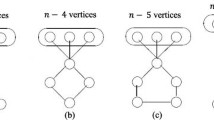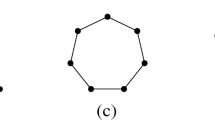Abstract
An open triangle is a simple, undirected graph consisting of three vertices and two edges. It is shown that the maximum number of induced open triangles in a graph on n vertices is given by \(\left( \frac{n}{2}-1\right) \lfloor \frac{n}{2}\rfloor \lceil \frac{n}{2}\rceil \). The maximum is achieved for the complete bipartite graph \(K_{\lfloor {n}/{2}\rfloor , \lceil {n}/{2}\rceil }\). The maximum expected number of open triangles in a uniform random graph on n vertices is observed to be asymptotically equivalent.


Similar content being viewed by others
References
Batagelj, V., Mrvar, A.: A subquadratic triad census algorithm for large sparse networks with small maximum degree. Soc. Netw. 23, 237–243 (2001)
Erdös, P., Rényi, A.: On random graphs. Publ. Math. 6, 290–297 (1959)
Goodman, A.W.: On sets of acquaintances and strangers at any party. Am. Math. Mon. 66, 778–783 (1959)
Lorden, G.: Blue-empty chromatic graphs. Am. Math. Mon. 69, 114–120 (1962)
Milo, R., Shen-Orr, S., Itzkovitz, S., Kashtan, N., Chklovskii, D., Alon, U.: Network motifs: simple building blocks of complex networks. Science 298, 824–827 (2002)
Moody, J.: Matrix methods for calculating the triad census. Soc. Netw. 20, 291–299 (1998)
Sauve, L.: On chromatic graphs. Am. Math. Mon. 68, 107–111 (1961)
Schank, T., Wagner, D.: Finding, counting and listing all triangles in large graphs, an experimental study. In: Nikoletseas, S.E. (ed.) WEA 2005: Experimental and Efficient Algorithms. Lecture Notes in Computer Science, vol. 3503, pp. 606–609. Springer, Berlin (2005)
Wasserman, S., Faust, K.: Social Network Analysis. Cambridge University Press, New York (1994)
Acknowledgements
The authors thank referees for their helpful remarks. The work of the first author was partially supported by the project 17-01-00170 of Russian Foundation for Basic Research and by the program of fundamental scientific researches of the SB RAS I.5.1., Project 0314-2016-0014. Partial support of the second and third authors by NSF Grant CMMI-1538493 is also gratefully acknowledged.
Author information
Authors and Affiliations
Corresponding author
Rights and permissions
About this article
Cite this article
Pyatkin, A., Lykhovyd, E. & Butenko, S. The maximum number of induced open triangles in graphs of a given order. Optim Lett 13, 1927–1935 (2019). https://doi.org/10.1007/s11590-018-1330-2
Received:
Accepted:
Published:
Issue Date:
DOI: https://doi.org/10.1007/s11590-018-1330-2




